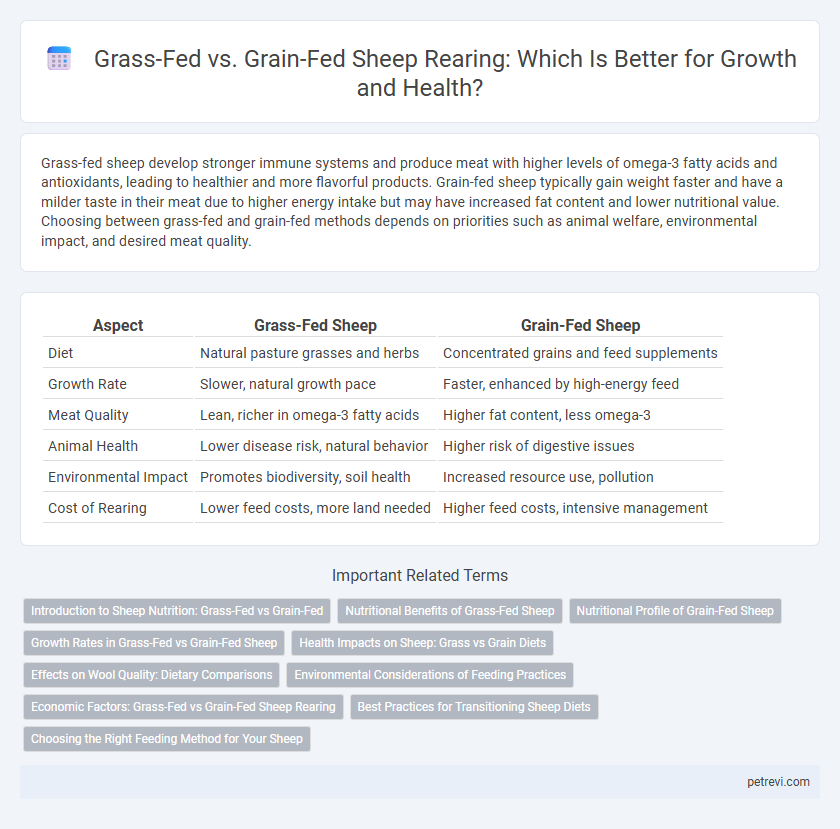Grass-fed sheep develop stronger immune systems and produce meat with higher levels of omega-3 fatty acids and antioxidants, leading to healthier and more flavorful products. Grain-fed sheep typically gain weight faster and have a milder taste in their meat due to higher energy intake but may have increased fat content and lower nutritional value. Choosing between grass-fed and grain-fed methods depends on priorities such as animal welfare, environmental impact, and desired meat quality.
Table of Comparison
| Aspect | Grass-Fed Sheep | Grain-Fed Sheep |
|---|---|---|
| Diet | Natural pasture grasses and herbs | Concentrated grains and feed supplements |
| Growth Rate | Slower, natural growth pace | Faster, enhanced by high-energy feed |
| Meat Quality | Lean, richer in omega-3 fatty acids | Higher fat content, less omega-3 |
| Animal Health | Lower disease risk, natural behavior | Higher risk of digestive issues |
| Environmental Impact | Promotes biodiversity, soil health | Increased resource use, pollution |
| Cost of Rearing | Lower feed costs, more land needed | Higher feed costs, intensive management |
Introduction to Sheep Nutrition: Grass-Fed vs Grain-Fed
Sheep nutrition varies significantly between grass-fed and grain-fed systems, influencing growth rates, meat quality, and overall health. Grass-fed sheep primarily consume natural pasture rich in fiber, promoting rumen health and producing leaner meat with higher omega-3 fatty acids. Grain-fed sheep diets concentrate on cereals and legumes, accelerating weight gain but potentially affecting digestive balance and increasing fat content in the meat.
Nutritional Benefits of Grass-Fed Sheep
Grass-fed sheep provide meat and dairy products rich in omega-3 fatty acids, conjugated linoleic acid (CLA), and antioxidants, which contribute to improved heart health and anti-inflammatory effects. The natural diet of fresh pasture enhances the nutritional profile with higher levels of vitamins A, E, and beta-carotene compared to grain-fed counterparts. Pasture grazing also promotes better animal welfare and reduces the need for antibiotics and synthetic additives, aligning with sustainable farming practices.
Nutritional Profile of Grain-Fed Sheep
Grain-fed sheep typically exhibit higher intramuscular fat and omega-6 fatty acid content, altering the nutritional profile compared to grass-fed counterparts. The elevated energy density from grains enhances growth rates but may reduce beneficial omega-3 fatty acids and increase saturated fats. This feeding strategy impacts meat tenderness and flavor, influencing consumer preferences and market value.
Growth Rates in Grass-Fed vs Grain-Fed Sheep
Grass-fed sheep typically exhibit slower growth rates compared to grain-fed sheep due to the lower energy density and digestibility of forage-based diets. Grain-fed sheep benefit from higher calorie intake, promoting faster weight gain and muscle development essential for market readiness. However, grass-fed rearing supports better animal welfare and can enhance meat quality through increased omega-3 fatty acids and antioxidants.
Health Impacts on Sheep: Grass vs Grain Diets
Grass-fed sheep benefit from a diet rich in natural forage, promoting better digestive health, higher omega-3 fatty acid levels, and enhanced immune function. Grain-fed diets often lead to faster weight gain but can cause digestive disorders, such as acidosis, and may negatively impact overall sheep well-being. Nutrient profiles differ significantly, with grass feeding supporting more balanced mineral and vitamin absorption essential for optimal sheep health.
Effects on Wool Quality: Dietary Comparisons
Grass-fed sheep typically produce wool with finer fiber diameter and enhanced crimp due to higher intake of natural forage rich in vitamins and minerals, which support follicle health. Grain-fed sheep often exhibit coarser wool fibers with reduced tensile strength, potentially linked to less diverse nutrient profiles in grain-based diets. Wool quality improvements correlate with forage diversity and nutrient availability in grazing systems compared to concentrated grain feeding.
Environmental Considerations of Feeding Practices
Grass-fed sheep produce lower greenhouse gas emissions compared to grain-fed sheep due to enhanced soil carbon sequestration in pasture-based systems. Grain-fed sheep rely on intensive crop cultivation that often involves higher water usage, fertilizer application, and fossil fuel consumption, contributing to greater environmental degradation. Pasture grazing supports biodiversity and reduces soil erosion, making grass-fed practices more sustainable for long-term ecosystem health.
Economic Factors: Grass-Fed vs Grain-Fed Sheep Rearing
Grass-fed sheep rearing typically incurs lower feed costs due to reliance on natural pasture, reducing the need for purchased grains and supplements. Grain-fed systems often require higher upfront expenses for feed and infrastructure but can lead to faster weight gain and shorter time to market, potentially increasing turnover rates. Economic decisions between grass-fed and grain-fed sheep depend on factors such as local feed prices, land availability, labor costs, and market demand for grass-fed lamb products.
Best Practices for Transitioning Sheep Diets
Transitioning sheep from grain-fed to grass-fed diets requires gradual introduction of pasture to prevent digestive upsets, with increments of fresh forage over 7 to 14 days ensuring rumen adaptation. Monitoring flock health and body condition score allows for timely adjustments, while providing consistent access to high-quality, nutrient-rich forage supports optimal growth and wool production. Balancing minerals and water availability during this period is critical to maintaining metabolic function and preventing common deficiencies associated with diet changes.
Choosing the Right Feeding Method for Your Sheep
Grass-fed sheep offer enhanced nutritional benefits, including higher omega-3 fatty acids and antioxidants, resulting from their natural diet of diverse pasture plants. Grain-fed sheep typically gain weight faster and achieve more consistent meat quality, favored in intensive farming systems where controlled growth is essential. Selecting the right feeding method depends on your production goals, land availability, and priorities for animal welfare and meat quality.
Grass-fed vs Grain-fed for Sheep Rearing Infographic

 petrevi.com
petrevi.com